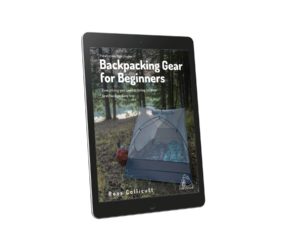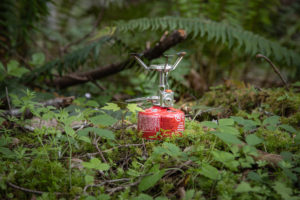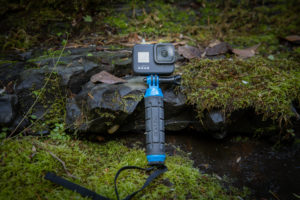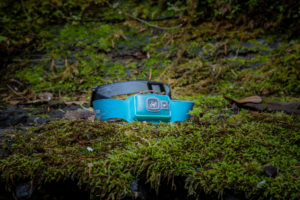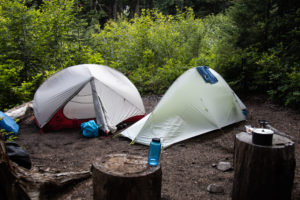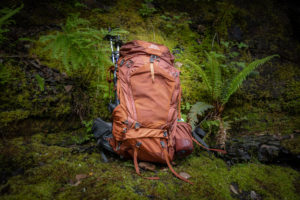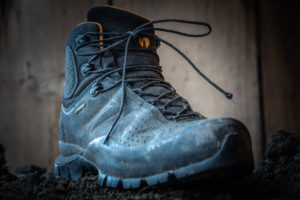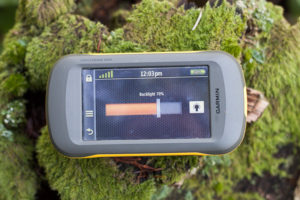Small, light backpacking tents are what most people use for shelter when they’re out backpacking. There are other options like hammocks and tarps but they require a little bit more experience and we don’t recommend you start there.
A backpacking tent is small, light and easy to set up. They can hold 1 to 4 people and usually are a mesh body covered with a waterproof fly.
On this page
How to Buy a Backpacking Tent
Size
The size of your backpacking tent will be your biggest decision. Is it a 1-person, just for yourself? Is it a 2-person for yourself and maybe 1 other? Or is it bigger for the whole family, maybe a 3- or 4-person?
Most people opt for a 2-person. The size is great for 2 people or nice and spacious for 1. Many tent pads and camping spots fit a 2- or 1-person tent well. The pieces divide up in half easy. The tent body can go into one persons tent and the tent poles and fly can go into another.
Weight
Size and weight are closely linked with backpacking tents. A 2 person tent is going to weigh more than a 1 person. A 3 person tent is going to weigh more than a 2 person.
There are certainly exceptions to this as the price gets higher and the fabrics get thinner and thinner. A more expensive 2- or 3-person tent with very thin, lightweight fabric can weigh less than a 1-person tent made from thicker, heavier materials.
Buy as light a tent as you can afford. It’s a large piece of gear in your pack and can weigh 4 or 5 pounds or more.
Durability
Even cheap tents are quite durable. The thicker the fabric the more durable it is. That said, you still have to be quite careful with tents. The mesh and fly are thin can tear easily. A waterproof fly with a hole in it isn’t waterproof any more.
Putting down a tarp or ground sheet (often called a footprint) protects the bottom of your tent from sharp sticks and rocks. It’s easier to replace a small tarp or piece of plastic under your tent than a whole tent body. As with everything else, it is something more to carry carry in your pack.
Non-Tent Shelter Options
Tents are usually the easiest to start with for backpacking but there are other options. Hammocks and tarps are 2 other ways to stay dry and warm when backpacking.
Hammocks
Backpacking hammocks aren’t your normal backyard hammock on a stand but the idea is the same. A very thin, light piece of fabric is hung between 2 trees. A bug net and tarp usually sit on top to keep you out of the bugs and rain. The ground doesn’t have to be smooth or flat under the hammock but there needs to be trees or rocks to attach either end of the hammock to.
Some people love sleeping in hammocks and some people hate it. It’s a good thing to test out at home before going on a week-long backpacking trip. With no poles to hold up the hammock, they often pack down smaller and lighter than backpacking tents do. Keep in mind they’ll always be 1-person.
Tarps
If you’re comfortable, pitching a tarp above you to protect you from the elements is all you need to sleep outside. There are many different shapes of tarps from regular rectangles to tent-shaped shells. Tarps usually require some way to pitch them and hold them up, with either trekking poles holding up either end or a rope from one tree to another. Tying edges and corners to trees or tent pegs will hold everything taught.
Nothing
The minimalist approach to camping is just throwing your sleeping bag on the ground and sleeping under the stars. This doesn’t offer any protection from bugs or rain but it can feel very freeing.
Tent Glossary
Bathtub floor – The waterproof floor that comes up about 6 inches from the ground. Keeps water out if you end up in a puddle in the middle of the night.
Fly – A tent fly is the waterproof fabric that goes overtop of the mesh body. Not all tents are 2 layers like this but most for backpacking are.
Footprint – A small nylon tarp that fits to the bottom of your tent and protects it from sharp sticks and rocks.
No-see-um Mesh – The very fine mesh built into the bodies of tents. Keeps out bugs like no-see-ums and mosquitos.
Gear Attic – An optional small hanging shelf in the top of some tents.
Tent Reviews
- Sea to Summit Telos TR2 Tent Review
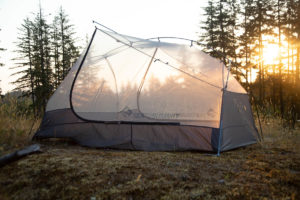 The Sea to Summit Telos TR2 Tent from Sea to Summit is a lightweight backpacking tent with a few features never before seen on a tent.
The Sea to Summit Telos TR2 Tent from Sea to Summit is a lightweight backpacking tent with a few features never before seen on a tent.
Other Backpacking Gear
You’ll need more than just a tent to head out backpacking. Here are buying guides to all the other gear you need for backpacking.
- Free Ebook: Backpacking Gear for BeginnersThere’s a lot of stuff you can take backpacking. But not all of it you should. Every wish there was a book that listed out… Read More »Free Ebook: Backpacking Gear for Beginners
- Backpacking StovesIf you want a warm meal on your backpacking trip then you’ll need some way to cook it or at least heat up the water.… Read More »Backpacking Stoves
- Cameras for BackpackingThere are 2 camps when it comes to hiking photos: those that never take a picture and just soak it all in and the rest… Read More »Cameras for Backpacking
- Headlamps: How to Buy One for HikingWhen the lights go out in the backcountry, it’s dark. Like really dark. If you want to do anything safely after dark, or get that… Read More »Headlamps: How to Buy One for Hiking
- Backpacking Tents: Everything You Need to KnowSmall, light backpacking tents are what most people use for shelter when they’re out backpacking. There are other options like hammocks and tarps but they… Read More »Backpacking Tents: Everything You Need to Know
- Backpacking Packs: Everything You Need to KnowSmall backpacks are great for day hikes and travelling but when it comes to staying out in the backcountry for multiple days we need something… Read More »Backpacking Packs: Everything You Need to Know
- Hiking Boots
Everything you need to know about hiking boots
- GPS for Hiking
Answers to all your questions about GPS units and phone apps.
